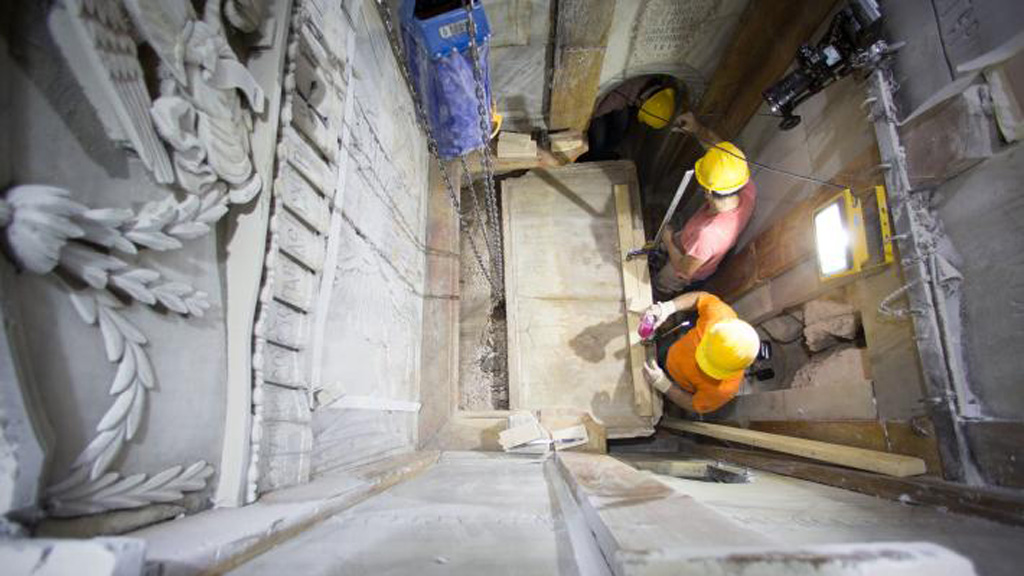Conservators and archaeologists opened the tomb of Jesus Christ, for the first time since 1555. For the historical event was observed by representatives of six Christian denominations – Greek Orthodox, Catholic, Armenian, Coptic, Syrian and Ethiopian, as well as officers of the Israeli police and security guards were Muslims.
the Church of the Holy Sepulchre in Jerusalem, also known as the Church of the Resurrection, was founded by St. Helen in the fourth century. Since then, it has repeatedly rebuilt, rebuilt, suffered from wars and natural disasters, rebuilt and grew. In 1555, an extension of the temple did the Franciscan monks. It is possible that the burial place and resurrection of Jesus Christ was covered with a heavy marble slab, extant.
“We moved the marble slab covering the tomb and were amazed, found it under number [stone] material. Scientific analysis is long, but in the end, we hope to see the real surface of the stone, which, according to the Holy Scripture, lay the body of Jesus Christ,” — said in an interview with National Geographic archaeologist Fredrik hibert (Fredrik Hiebert) restoration project.
“Stone material” is a mass of brownish-gray stones, found under a shifted hob. On the question of observers “what is it?” the head of the restoration project Moropoulou Antonia (Antonia Moropoulou) said, “We don’t know. Carry equipment for research.”

Removing the marble slab from the tomb of Jesus Christ in the Holy Sepulchre. Photo: Dusan Vranic, AP National Geographic
In accordance with Jewish burial traditions of the first century of our era, the body of Jesus Christ rested on the stone bed size 80 200 cm at a height of 60 cm from the floor in a tomb cut into the natural rock. Upcoming studies will allow us to study the original design of the tomb and find out what was the surface of the stone where, according to tradition, three days lay the body of Jesus Christ. Experts also hope to find the answer to a major question: why is St. Helena ordered to build a temple of the Holy Sepulchre that cave? How the mother of St. Constantine, visited the Holy Land three centuries after the crucifixion, burial, and resurrection of Jesus Christ, was able to determine that this place is the main Christian Shrine?
in the fourth century over the Holy burial bed was built Edicule (Aedicule or, the aedicule from the Latin, “little house”) – domed chapel made of marble. For 17 centuries, the Edicule has been repeatedly destroyed, but the funeral bed, the part of the cave walls and the entrance survived. Edicule, which see modern-day pilgrims, was built in 1808-1810 years on the site of the old, destroyed by fire. In 1927 she suffered in the earthquake. In 1947, when Jerusalem was still the administrative center of English mandated territory of Palestine, on orders of the British authorities Edicule was fortified on the outside and sides with steel beams and ties.
the Chapel over the Sepulchre was in desperate need of restoration, but the lack of funding and lack of consensus between the representatives of the six Christian denominations decades has slowed down the process – a similar situation in his time has developed around other Christian shrines, the Basilica of the Nativity in Bethlehem.
In 2015, Greek Orthodox Patriarchate of Jerusalem, with the consent of the representatives of the Catholic and Armenian churches, was invited to survey the Edicule of specialists from the National technological University of Athens with experience in the restoration of such monuments of world importance like the Acropolis and Hagia Sofia in Istanbul. In March 2016 were received universal agreement on the reconstruction of the Edicule and the Tomb. The cost of the restoration and research of the project exceeds $ 4 million, the largest donation was made by the king Abdullah II of Jordan and the designer, Mika Ertegun, widow of the founder of the record company Atlantic Records.
an International team of restorers headed by Professor Anthony Moropoulou from the National technological University of Athens. According to her, modern scientific and technological methods allow to make the results of the restoration available to researchers around the world, “as if they visited the tomb of Jesus Christ.” In the archaeology section meets Fredrick hibert from the National geographic society (USA). The National Geographic Society in its media incarnation – channel, magazine and website got the exclusive inside scoop and restoration works on the Church of the Holy Sepulchre.
All work will be completed by Easter 2017.
No comments:
Post a Comment